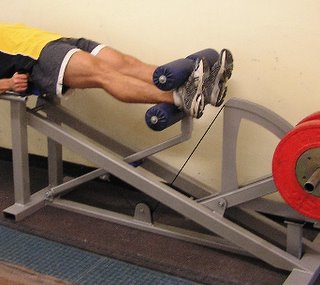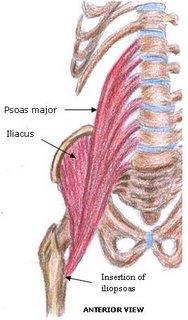
After extensive prototype testing, MyoQuip is proud to release the HipneeFlex, a truly unique apparatus for the development of the hip and knee flexors.
The HipneeFlex permits the hip flexor and knee flexor muscles to be exercised simultaneously through the full range of leg movement from full extension to full flexion. Both sets of muscles are subjected to substantial but appropriate loading throughout the whole movement.
Figure 1 shows the basic mechanism of the HipneeFlex. The athlete operates from a supine position so that the action of the flexors - iliopsoas and hamstrings for the hip and knee joints respectively - can be effectively isolated. The feet are engaged between rollers which are cable-connected to the weighted QuadTorq mechanism.

The exercise movement involves the feet being drawn back from a fully extended position to a fully flexed position. Thus both hip and knee flexors are exercised through a range where the included angle at the joints varies from 180º to around 30º.
The arc through which the foot engagement device moves is designed to closely parallel the path that the feet would normally traverse if drawn back without resistance. It also creates a natural tendency for the two joint angles to vary synchronously so that they are both under continual load.

Biomechanical correspondence In going from full extension to full flexion the limb joints are moving towards a progressively inferior biomechanical orientation and consequently, less capacity to handle load.In view of this the QuadTorq mechanism for the HipneeFlex is configured for decreasing resistance. (This is opposite to MyoQuip's other machines, the ScrumTruk, JumpTruk and HipneeThrust. Because they involve limb extension rather than limb flexion their QuadTorq orientation is for increasing resistance.)
Hamstring development It could be argued that other exercises and apparatus cater adequately for hamstring development. For example, in their role as hip flexors, they are strongly activated in whole-leg extensor movements such as the barbell squat. But with regard to their other function as knee flexors the most commonly used apparatus, the leg curl machine, doesn't usually involve knee joint closure much below 90º and it is also a simple single-joint exercise. By contrast, many of the important sporting activities involving the knee flexor, such as sprinting, cycling or rowing, produce acute joint angles and also require complex coordination between the hamstrings and iliopsoas. The HipneeFlex is the only strength apparatus that effectively simulates that coordination.
Hip flexor strength and sport The most widely recognised sport-related function of the iliopsoas is in enhancing knee lift in sprinting. They also play a vital role in football kicking, swim kicking and sports such as rowing.
Iliopsoas strengthening has specific performance implications for cycling which involves continuous though offsetting leg extension and flexion. Enhanced hip flexor capacity has particular relevance to the cycling upstroke where both hip and knee joints are flexing. Concentration on using the hip flexors takes load off the hamstrings, the most overworked muscles in cycling.
Cross country skiing is particularly taxing on the hip flexors, as are other activities involving vertical movement of the body such as cross country running and mountain climbing.
Some of the more athletic forms of dance necessitate very strong hip flexors.
More generally, in any sporting activities requiring hip joint extension, the hip flexors perform a crucial antagonist function.
Tight hip flexors are recognised as contributing to lower back pain by causing the pelvis to tip forward. Full range activation of the iliopsoas through use of the HipneeFlex can be expected to have a beneficial effect on flexor flexibility.
Hip flexor development Until now the hip flexors have been the most neglected muscle group in strength training. Now with the release of the HipneeFlex there is a machine that has significant specificity to natural movement of these muscles, that involves their full range activation and that has a high degree of biomechanical correspondence between effective load and load-bearing capacity of those muscles at a particular limb position.
Athletes and their coaches constantly seek minor improvements that could conceivably give them a competitive edge. Here we have an apparatus that can safely and effectively strengthen a muscle group that is intrinsically involved in many athletic and sporting activities but which is virtually never developed to its full potential.
No one really knows the extent of the benefits that will flow from eliminating that imbalance.

We invite you to be one of the first to explore the potential of really strong hip flexors. Alternatively, you can wait and then play "catch-up" with the rest of the herd.
If you are located outside Australia please use the email link in the sidebar to obtain a quotation in your own currency including shipment options.
(See also my previous post, Hip flexors - the most underdeveloped muscle group in strength training.)
Read more...










